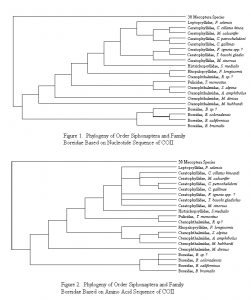Sonia Bake and Dr. Michael Whiting, Zoology
Purpose
The intent of this study is to determine the phylogeny of the order Siphonaptera (fleas) and their relationship to the order Mecoptera (scorpion flies) including the Boreidae family (snow fleas) which have traditionally been placed with the scorpion flies. A study is being conducted using molecular data from several genes and morphology to design a more accurate phylogeny for these orders. This study uses the data from a single gene, cytochrome oxidase II or COII, to create a tree for several species from these orders.
Methods
Templates had been acquired and extracted from specimens collected by M. Whiting and primers had been designed for bees, flies, and beetles. Templates that had yielded good products for other genes were used to amplify the COII gene in a process called polymerase chain reaction (PCR). Products were purified, cycle sequenced with florescent dideoxy-nucleotides and sequenced in an automatic sequencer. Resultant sequences were used to design new primers specific to these two orders.
Using these primers, PCR was performed on all templates using 94 degrees(, 1 minute, denaturing; 54(, 1 minute, annealing; and 72 degrees (, 1 minute, extending for 33 to 40 cycles. Products were purified, cycle sequenced, and sequenced in the automatic sequencer. Resultant sequences were proofed and aligned using Sequencher. Phylogenetic analysis of the DNA sequences and amino acid sequences was completed using PAUP which creates phylogenetic trees that are parsimonious or have the fewest evolutionary events.
Results
Snow fleas have traditionally been grouped by morphology with the order Mecoptera and it was thought that they evolved characteristics similar to fleas by convergence rather than by divergence from a common ancestor. The Boreidae family is wingless and is very good at jumping, traits characteristic of fleas. Yet they are not laterally flattened and are thus morphologically similar to scorpion flies. Entomologists believed that fleas evolved winglessness and jumping as adaptations after they had become ectoparasites of mammals and that snow fleas evolved these traits as adaptations to their environment.
Phylogenies based on morphology are often biased by speculations such as these. Molecular data is unbiased in this regard. Analysis from nucleotide and amino acid sequences of the COII gene suggest an alternate system for how fleas evolved (see figures 1 and 2). These data suggest that fleas and boreids evolved from a common ancestor with boreids being more primitive. This would suggest that winglessness and jumping were pre-adaptations in snow fleas. An ancestor hopped onto mammals and from there fleas evolved laterally flattened bodies as an adaptation to their ectoparasitic lifestyle.

